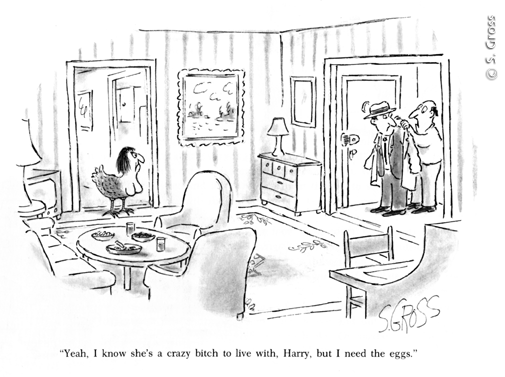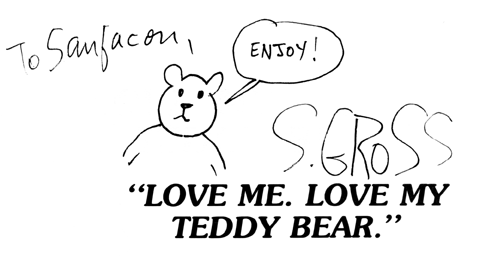![]()
![]()


Back in 1977, as a freshman at the Art Institute of
"Jumping Up and Down on the Roof, Throwing Bags of Water on People," by Mark Jacobs (Dolphin Books, 1980), featured extensive interviews with Sam Gross ("Shrunken Heads and Gingerbread Boys") and B. Kliban ("Free Rubber Chickens Regardless of a Person's Religious Beliefs"), shedding light for the first time on the real-life personalities of my two favorite cartoonists.

The first Sam Gross book I bought was actually his second book, "I Am Blind and My Dog Is Dead" (
His drawing style is very relaxed and free, the type of style that aspiring cartoonists mistakenly assume can be easily imitated. His use of gray washes is remarkable. His sense of composition, without a single extra element, is still something I strive for. But my approach is so different that I don't think I'll ever get it. Letters In the '80s I wrote several letters to Mr. Gross, sending along samples of my own cartoons, asking for advice, inquiring about his influences, etc. Just pumping him for any information I could. He was very gracious and actually sent several replies. I have included copies of those replies here. As Mr. Gross states in the first line, I wrote to him in October of 1985, and got this reply less than three weeks later. Needless to say, I was thrilled to get his letter because I'd never written to a cartoonist before, let alone gotten a reply. This was my first. I had asked him how he came up with his ideas, what he uses for pens, and how he got started. I'd asked if he wouldn't mind sending me copies of some of his sketches so I could witness his thought process. He didn't think that was a good idea at all. I also gushed like a groupie, hoping that that would ensure a reply. I didn't realize until later that he was genuinely interested in helping someone who was just starting out. Autograph received in reply envelope. I wrote him again a few weeks later. I thanked him for his earlier reply and, of course, asked him more questions. I also sent along some copies from a cartoon book idea I was working on at the time based on the '80s Heavy Metal music scene ("Fists in the Air"). It was a pretty narrow focus and as time went on I realized I really had no idea at all. So as soon as it got quickly and soundly rejected by several publishers I scrapped the idea. You'll note that he restates his tip on getting into the business; the method he used in the early '60s. This was something I just couldn't do. Who could take a year off? Sam Gross had made a decent living as an accountant before hitting the cartoon jackpot and was able to save up a year's worth of cash. Letter 3 February 1987. His book Love Me. Love My Teddy Bear had been released the previous spring and I had been cranking away on more cartoons, four of which I'd photocopied and sent along with my letter. His responses to my innumerable questions, this time, were handwritten within the margins and in the text of my original three-page letter. He apologized for the "scrawling answers" but I thought it was pretty cool. Quotes from the letter When asked if certain cartoons call for washes or is it just a part of his day-to-day technique, Mr. Gross replied, "Certain cartoons call for it. Somehow you just know; call it experience." I asked if he had some kind of "formula" for brainstorming for ideas: "Doodling works best but I also get gags walking down the street so I always carry a pen & a little note book with me. There's really no formula." On finding a market for cartoon books: "The publishers are always looking for what they call 'the handle.' Usually this is determined by the Sales & Marketing department and it's the thing that will appeal to the public, whether it be cats, food, sex or money. (What else is there?)" Closing remarks: "Dear Pete, Sorry for the scrawling answers on your letter. I just got back from a trip to
Notes on four drawings Note No. 1: Mr. Gross identified a common theme of my cartoons of the period. Although he told me to avoid this type of gag, I simply refined the drawing a bit. This cartoon can now be found in F,G&CB. Note No. 2: This cartoon is also featured in F,G&CB. It was redrawn with a much simpler caption just prior to publication. Note No. 3: I must admit that I didn't heed his advice on this one either. It made it into F,G&CB unchanged. Note No. 4: Check this one out. Not only was he kind enough to provide an objective critique, he doodled a little "like this" cartoon. I was flabbergasted that he would do an S. Gross original for me right under my own drawing! I had originally drawn this one as a typical gag cartoon,but after Mr. Gross' suggestions, I converted it into a nifty little Christmas card. (Note the shocked person taken shamelessly right from Mr. Gross' sketch.) Autograph I picked up my copy of the book as soon as it arrived at the local bookstore and sent it out to Mr. Gross in February 1987 with a request for an autograph. He signed it and sent it right back.

